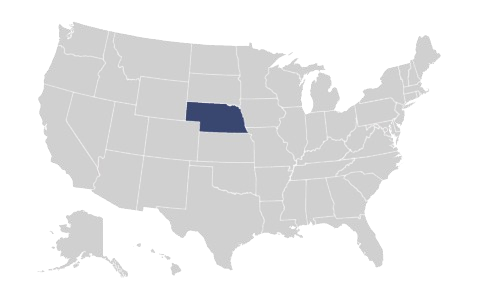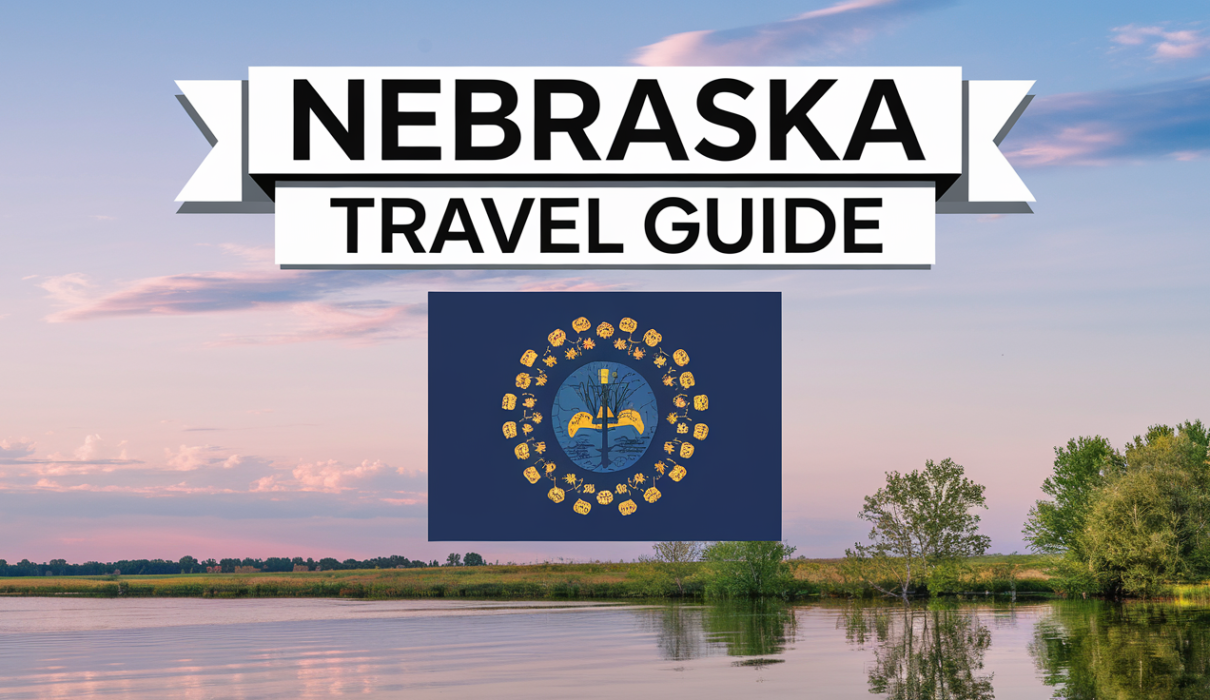Nebraska: A journey of discovery through the American Midwest
A state that is often underestimated, Nebraska holds an unexpected diversity and unique charm that draws visitors from all over the world. Characterized by vast prairies, rolling hills, and bustling cities, Nebraska embodies the beauty and spirit of the American Midwest. This multifaceted state offers a rich array of experiences for history buffs, nature lovers, and adventure seekers.
A journey through history
Nebraska is a land with deep historical significance dating back to prehistoric times. The traces of various indigenous peoples who inhabited the area as early as 8000 BC, as well as the Pawnee, Oto, Omaha, Oglala, Sioux, Arapaho and Comanche, testify to a rich cultural past. As part of the Louisiana Purchase, Nebraska became part of the United States in 1803 and played an important role in America’s western expansion, particularly along the Oregon Trail.
Natural beauty and urban culture
From the scenic banks of the Missouri River to the vast plains of the Platte River, Nebraska offers stunning natural scenery. Bordering South Dakota , Iowa , Missouri , Kansas , Colorado and Wyoming , the state’s unique geography invites numerous outdoor activities. At the same time, Omaha and Lincoln, Nebraska’s cultural and industrial centers, are vibrant cities with a lively cultural scene that ranges from music to art to culinary delights.
Agriculture and Industry
Most of Nebraska is agricultural, with food processing and engineering being important industries. Petroleum, the state’s most important natural resource, underscores the state’s economic diversity. Nebraska is also known for its unique unicameral legislature, the only one of its kind in the United States, introduced in 1937, which reflects the state’s innovative spirit.
Discover the unexpected Nebraska
Nebraska invites you to discover its unexpected diversity and charm. Whether you follow in the footsteps of the early pioneers, enjoy the natural beauty of the landscape or explore the cultural diversity of the cities – Nebraska offers a wealth of unforgettable experiences. Immerse yourself in history, enjoy the hospitality of the locals and discover the hidden treasures of this unique state in the heart of America.
Nebraska may seem like an unremarkable part of the Midwest at first glance, but its rich history, stunning nature and vibrant urban culture make it a place worth exploring. Be inspired by the beauty and spirit of Nebraska and create unforgettable memories in this diverse and welcoming state.
Flag

The flag of Nebraska was adopted in 1925, nearly 70 years after Nebraska became a state. It consists of a blue background with the state seal centrally placed. The seal, designed by Isaac Wiles, a Nebraska justice, was originally adopted in 1867 and depicts a variety of scenes highlighting the state’s agriculture and natural resources.
In the foreground of the seal is a blacksmith working at an anvil, symbolic of the importance of labor and industry in Nebraska’s history. Behind him is a newly planted field growing wheat and corn, two important crops in the state. A steam locomotive passes in the background, symbolic of progress and the importance of railroading in the state’s development. A river and mountains are also depicted in the background, representing Nebraska’s natural beauty and diversity.
Above the seal is the state slogan “Equality Before the Law” in gold letters, a statement of the values of justice and fairness that Nebraskans uphold.
| Capital city | Lincoln |
|---|---|
| Largest city | Omaha |
| Resident | 2 million |
| Founding | March 1, 1867 |
| Time zone | Central: UTC−6/−5Mountain: UTC−7/−6 |
| Area | 200,000 km² |
| Left: | nebraska.gov |

Highlights of Nebraska
Often referred to as the heart of the American Midwest, Nebraska offers an impressive variety of natural beauty, historic sites and cultural experiences.
Chimney Rock National Historic Site
Chimney Rock, a striking natural monument and landmark of the pioneer era, once served as a guide for settlers on the Oregon Trail. The visitor center offers fascinating insights into the history of the westward-moving pioneers.
Sandhills
The Sandhills, one of the largest dune areas in the Western Hemisphere, offer a unique landscape of rolling hills and prairies. This region is a paradise for nature lovers and offers opportunities for hiking, bird watching and exploring the pristine natural environment.
Carhenge
Carhenge, a creative recreation of Stonehenge made from old cars, is one of Nebraska’s most unusual attractions, attracting visitors who appreciate the curious and unique.
Omaha’s Henry Doorly Zoo and Aquarium
The Omaha Zoo and Aquarium is one of the premier facilities of its kind in the world, featuring impressive exhibits such as the largest indoor rainforest, the Desert Dome, and a massive aquarium.
The Nebraska State Capitol in Lincoln
The Nebraska State Capitol, with its impressive architecture and tall tower visible from miles around, serves not only as the seat of government but also as a cultural landmark with works of art and a rich history
Niobrara National Scenic River
Flowing through scenic landscapes and ecologically diverse areas, the Niobrara River offers excellent opportunities for canoeing, kayaking, fishing and wildlife viewing.
The Strategic Air Command & Aerospace Museum
The museum near Ashland is dedicated to the history of aviation and space travel as well as the strategic air command history of the USA and houses an impressive collection of aircraft and missiles.
These highlights are just a few of the many incredible attractions Nebraska has to offer. Whether you’re a nature lover, history buff, or culture buff, there’s something for everyone in Nebraska.
National Parks, State Parks,
The Sandhills: Nebraska’s vast wonders
One of Nebraska’s most distinctive features is the Sandhills, one of the largest dune systems in the Western Hemisphere. These gently rolling, grassy dunes stretch across much of the state and provide a stunning backdrop that is unique in the United States. The Nebraska National Forest near Halsey, which is surprisingly located in the middle of the Sandhills, is a striking demonstration of the commitment to reforestation and conservation in a region that one would not initially associate with forest areas.
On the banks of the Platte River
The Platte River , which meanders through Nebraska, plays a central role in the ecological and cultural life of the state. In spring, the river becomes the stage for one of North America’s most spectacular natural spectacles: the mass migration of sandhill cranes. Areas like the Rowe Sanctuary offer visitors the opportunity to experience this natural spectacle up close and understand the importance of river ecosystems for bird life.
Historic prairies and the restoration of nature
Despite extensive agricultural use, Nebraska has preserved parts of its original prairie landscapes and is actively working to restore them. The Spring Creek Prairie Audubon Center showcases the beauty and ecological importance of the tallgrass prairie, an ecosystem that once covered much of the Midwest and is now one of the most endangered ecosystems in the world.
Wildlife observation and conservation
For nature lovers, Nebraska offers an abundance of wildlife that calls the state’s diverse habitats home. From the majestic bison at Fort Niobrara National Wildlife Refuge to the prairie dogs and beavers that roam along the waterways, there are countless opportunities to view wildlife in their natural habitat and support conservation efforts for these species.
Cities
Cities in Nebraska
Often described as the heart of the American Heartland, Nebraska may at first glance be characterized by its vast prairies and agricultural lands, but its cities tell the stories of rich cultural heritage, innovative communities and a deep connection to American history. From Omaha’s vibrant cultural districts to Lincoln’s historic sites, Nebraska offers a variety of urban experiences that invite visitors to discover the state’s warm hospitality and unexpected diversity.
Omaha , Nebraska’s largest city, is a cultural melting pot known for its dynamic arts scene, excellent restaurants and historic Old Market District. Omaha’s Henry Doorly Zoo and Aquarium is considered one of the best of its kind in the world and attracts families and nature enthusiasts alike. Omaha is also home to the annual College World Series, which draws baseball fans from across the country.
Lincoln , the state capital, reflects the spirit of Nebraska with its magnificent State Capitol, an architectural masterpiece, and a variety of museums exploring the region’s rich history. The city is home to the University of Nebraska, whose campus enriches the city’s cultural and social life and ensures a vibrant exchange of ideas and innovation.
Smaller cities like Kearney and Grand Island offer a glimpse into Nebraska’s agricultural heritage, with museums and annual festivals that celebrate the history and importance of agriculture to the state. North Platte , meanwhile, is known for the annual Nebraskaland Days Festival and the historical significance of the Union Pacific Railroad, which teaches visitors about the development of railroading and its influence on the settlement of the American West.
In Scottsbluff, visitors can explore monumental relics of the pioneer era, including Scotts Bluff National Monument , which served as a landmark for settlers on the Oregon Trail.
Places worth seeing
In addition to the vast landscapes, Nebraska also offers numerous worthwhile stops that invite you to discover the lesser-known side of Nebraska.
The Sandhills , one of the largest dune areas in the Western Hemisphere, offer a surprisingly scenic landscape that stretches across much of Nebraska. These gently rolling grasslands are not only a sight of breathtaking beauty, but also an important ecosystem that supports a variety of wildlife.
At Chimney Rock , a prominent landmark on the Oregon Trail, visitors can follow in the footsteps of the pioneers who once settled the West. This historic site is not only a symbol of America’s westward expansion, but also offers spectacular views of the surrounding landscape.
Carhenge , a quirky replica of Stonehenge but built from old cars, offers a unique and photogenic stop in western Nebraska. This work of art reflects American ingenuity and humor and is a popular draw for visitors.
The Strategic Air Command & Aerospace Museum near Ashland offers fascinating insights into aerospace history and military artifacts. Exhibits range from historic aircraft to interactive space displays and honor Nebraska’s role in U.S. air defense history.
In Omaha , Nebraska’s largest city, the vibrant Old Market District combines historic flair with modern urban living. Visitors can stroll the cobblestone streets, browse unique shops, and enjoy the local food scene.
The Niobrara River Valley offers a surprisingly diverse landscape with waterfalls, rapids and rich biodiversity. A canoe or kayak tour on the Niobrara River offers the opportunity to experience the tranquil beauty of this region.

5 Great Restaurants in Nebraska
- Crave in Omaha is a great restaurant for those interested in American and Italian cuisine. The food is fresh and innovative, and there is a wide selection of drinks.
- Stuhlmanns in Lincoln is a perfect restaurant for meat lovers. The steak here is absolutely amazing and the ambience is very classy and elegant.
- Dixie Quicks in Omaha is a delicious BBQ restaurant that also serves great burgers. The atmosphere is very relaxed and cozy, and they always have a good selection of drinks.
- The Upstream Brewing Company in Omaha is a first-class brewery that brews excellent beers and serves excellent American food. The atmosphere is very pleasant and modern, and there is always live music.
- The Brickyard in Lincoln is a great sports bar with great food and drinks. The atmosphere is very casual and sportsy and there are always lots of people here to watch the games.
Where to stay in Nebraska
Nebraska, a state known for its vast prairies and rich pioneer history, offers visitors a variety of lodging options, ranging from cozy bed and breakfasts in historic towns to modern hotels in larger cities like Omaha and Lincoln. The price range for lodging varies depending on location and season.
Omaha and Lincoln : Nebraska’s larger cities are home to numerous hotels and motels that offer a wide range of prices, from budget options starting at $70 per night to more upscale accommodations that can cost $200 and more. These cities also offer a variety of cultural attractions and dining experiences.
Sandhills and Rural Areas : For visitors looking to explore rural Nebraska, charming bed and breakfasts and inns are a popular choice, often located in historic buildings or amidst the scenic landscape of the Sandhills. Prices for these accommodations can range from $80 to $150 per night, but often offer an authentic experience and personalized service.
State Parks and Natural Areas : Nebraska’s state parks like Fort Robinson State Park or Niobrara State Park offer cabins, campgrounds and lodges for nature lovers. Prices for cabins start at around $50 per night, while campgrounds offer a more affordable option starting at around $15 per night.
Cottages and Ranches : In some parts of Nebraska, especially in the Sandhills or near nature preserves, cottages or even entire ranches can be rented. These often offer a unique experience in nature and prices vary greatly depending on size and location.
Camping and RV Parks : For those who prefer to stay close to nature, Nebraska has numerous camping and RV parks. These often offer basic amenities and are an inexpensive way to explore the state. Prices for campsites typically range from $10 to $30 per night.
Facts
5 Interesting Facts About Nebraska
- The first Europeans arrived in the area that later became Nebraska in the late 17th century.
The French explorer Etienne de Bourgmont first used the name Nebraska in its French form, Nebraskier, in 1714. - After the Seven Years’ War, France ceded all its claims to the present state to Spain.
- Democrats dominated Nebraska politics until the end of the 19th century. Starting in the 20th century, Republicans took control of the state.
- The name is derived from the Native American words Ñíbrahge and Ní Btháska, both meaning “shallow water” and both referring to the Platte River.
Reasons
3 Reasons to Visit South Nebraska
South Nebraska is a laid-back place where the people are nice and there are plenty of interesting places to visit. The town is small enough to feel like home, but there is also plenty to do and see. South Nebraska is a great place for outdoor activities such as horseback riding, hiking, biking, and canoeing. There are also some interesting attractions around the town, including historic buildings, museums, and parks.
- The landscape is breathtaking: from the sand dunes of the Panhandle to the vast prairies in the east, there is incredible diversity to discover here. In fact, some parts of the state have been designated as national monuments and national parks to preserve their beauty for posterity. Whether you want to explore the unique landscape by bike, on foot, or even by car, Nebraska is a great place to enjoy nature.
- Cities are full of life: Nebraska is known for its rural character, but that doesn’t mean the state’s cities are boring. Omaha, the largest city, is full of things to see and do, from great restaurants and museums to theaters and sporting events. Lincoln, the state capital, also offers a variety of cultural activities and a lively nightlife scene.
- The people are warm and friendly: No matter where you go, you’ll find that the people here are warm and friendly. The hospitality is even more pronounced in the rural areas of the state – here you can count on a warm welcome as soon as you arrive. This friendliness is also one of the reasons why so many people want to live in Nebraska.
Travel tips
Insider tips for Nebraska
- Wide horizons: Nebraska is known for its vast expanses and stunning landscapes. Drive along Nebraska Highway 2, known as “The Sandhills Journey Scenic Byway,” and experience breathtaking views of rolling hills and pastures.
- Wild West History: Nebraska has a rich Wild West history. Visit Boot Hill Cemetery in Ogallala, where famous outlaws are laid to rest, or explore Fort Robinson State Park, once a military base and now a living museum.
- Impressive Sand Dune: Head to Crescent Lake National Wildlife Refuge and explore the massive sand dunes that rise amidst the prairie landscape. Experience the feeling of being in a desert as you explore the majestic sand formations.
- Local Cuisine: Nebraska is known for its hearty, down-to-earth cuisine. Try the popular dish “runza,” a type of stuffed roll, or savor the juicy “Nebraska steak” at one of the state’s many excellent steak restaurants. Don’t forget to try the delicious homemade ice cream from the local ice cream parlors.
- Fossils: Nebraska is rich in fossil sites, especially dinosaurs. Visit Ashfall Fossil Beds State Historical Park and marvel at the well-preserved skeletons of prehistoric animals. Learn about the fascinating history of dinosaurs and discover the work of local paleontologists.
- Native American Cultural Heritage: Immerse yourself in the rich culture of Native Americans by visiting reservations and cultural centers in Nebraska. Learn about the Lakota and Dakota tribes at the Pine Ridge Indian Reservation or explore the Santee Sioux Reservation and learn about the native communities and their traditions


